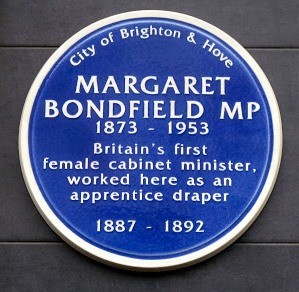Margaret Bondfield (1873 – 1953) Britain’s First Cabinet Minister
This is a legacy story from an earlier version of our website. It may contain some formatting issues and broken links.
One of the most recent blue plaques to appear in Brighton & Hove honours Margaret Bondfield, who in 1929 became Britain’s first female cabinet member. Although her birthplace was in Somerset, it was in Hove where Margaret became politicised and formed the views that would shape her political career.
Bondfield was fourteen when she arrived in Hove to serve an apprenticeship in a Mrs White’s drapers shop in Church Road. Although she, herself, was relatively well looked after while serving her apprenticeship, she couldn’t help noticing that female apprentices elsewhere endured poor wages, miserable living conditions and no opportunities to change things. Most ‘shop girls’ at the time worked in the ‘living-in’ system which forced them to live on the shop premises at the beck and call of the owners, with poor food, low wages, no freedom, and vulnerable to exploitation and abuse. The teenage Bondfield became friends with Louisa Martindale (mother of Brighton’s first female GP, Dr Louisa Martindale), a woman who believed in equality for women and the relationship helped Bondfield’s sense of injustice at the shop girl’s lot solidify into a strong conviction that things could – and should – change, and a commitment to be part of the process.
Moving to London in 1894 it didn’t take Bondfield long to put her ideas into practice. In a few years, due to her hard work and fearlessness to swim against the tide, she was considered the leading authority on shop workers, the assistant secretary to Shop Assistants Union District Council, investigating pay and conditions and regularly reporting her findings to Parliamentary Committees. In the early years of the 20th century, she was at the forefront of attempts to improve working women’s lives, co-founding the first trade union for women, advising the Liberal Government on improving maternity benefits, and militating for improvements to child welfare, reduction in infant mortality rates and minimum wage laws. She was also chair of the Adult Suffrage Society, believing that suffrage should be extended to all adults regardless of gender or property. In 1923, the same year she became secretary to the TUC General Council – and on her third attempt – Bondfield was elected Labour MP for Northampton. Although she lost her seat the following year, she won again for Wallsend and in 1926 served in Prime Minister Ramsay MacDonald’s government. From 1929 to 1931 she made history when she was made Minister for Labour, Britain’s first Cabinet Minister.
She fell from popularity when, against the backdrop of the Depression, she supported government policy to cut unemployment benefit for some married women. An unpopular policy with voters, Bondfield lost her seat in 1931. Bondfield remained active in the National Union of General and Municipal Workers until 1938.
Margaret Bondfield achieved an incredible amount during a short period of time, fighting for – and usually gaining – improvements in working conditions, living standards, and overall equality. Any woman today who has ever had a job owes her a debt of gratitude.
The blue plaque for Margaret Bondfield now stands on the premises of the former drapers shop where she worked as an apprentice – today a Nisa convenience store in New Church Road. It was unveiled by Labour MP for Hove, Peter Kyle who researched Margaret’s life in Hove, and campaigned for the plaque alongside the Brighton Women’s History Group and the Commemorative Plaque Panel. He was accompanied at the plaque unveiling by Rachel Reeves MP who included Margaret in her book The Women of Westminster.
Written by social historian Louise Peskett.
Women are still breaking new ground in the political arena today. The current exhibition, 100 First Women Portraits, by Anita Corbin, features Rt. Hon. Nicola Sturgeon MSP, who was the first woman to be First Minister for Scotland. She has held that role since 2014. She was also the first female leader of the Scottish National Party.
It also features Rt Hon.the Baroness Helene Hayman GBE PC who changed history when she became the first elected Lord Speaker in the House of Lords in 2006. She had previously been the youngest member of the House of Commons and the first woman to bring her new baby into Parliament when refused maternity leave.



